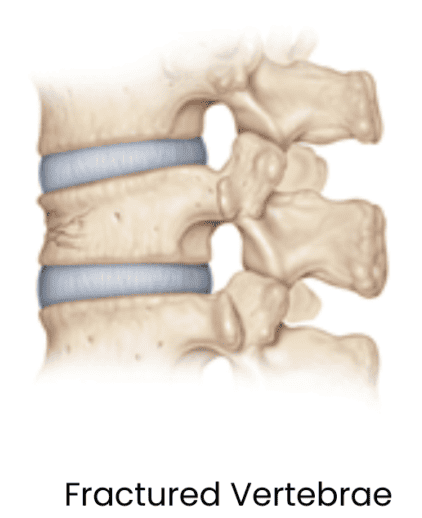What is a Vertebral Compression Fracture?
- What are the Symptoms of a Vertebral Compression Fracture?
- What Are the Risk Factors of a Vertebral Compression Fracture?
- How is a Vertebral Compression Fracture Diagnosed?
- What are Treatment Options for Vertebral Compression Fracture?
- Who Should Consider Surgery for Vertebral Compression Fracture?
A vertebral compression fracture occurs when the bones of the spine break. They can occur anywhere in the spine, but tend to occur most commonly in the thoracic (mid-back) spine or in the upper section of the lumbar (low back) spine.

What are the Symptoms of a Vertebral Compression Fracture?
Symptoms include:
- Acute (sudden) back pain
- Walking and/or standing cause pain to be worse
- Pain is less intense when lying down
What Are the Risk Factors of a Vertebral Compression Fracture?
Risk Factors for Vertebral Compression Fracture:
- Excess weight: causing more stress of joints that are weight-bearing
- Trauma – sports related, motor vehicle accidents
- Gender – seen more in women over the age of 45
- Medical conditions: osteoporosis, tumors
- Smokers
How is a Vertebral Compression Fracture Diagnosed?
After an examination and a review of your past medical history your spine surgeon or his physician assistant will order x-rays and an MRI to determine exactly which level of your spine in affected. Your physician may also request a bone scan to determine the possible cause for the fracture. The bone scan is used to detect osteoporosis and may require further evaluation for additional therapies. After diagnostic testing is completed your physician will determine your treatment plan.
What are Treatment Options for Vertebral Compression Fracture?
 Typically vertebral compression fractures are treated non-surgically. Rest, ice or heat for local pain, bracing and pain medication will help with return of mobility.
Typically vertebral compression fractures are treated non-surgically. Rest, ice or heat for local pain, bracing and pain medication will help with return of mobility.
When non-surgical treatment fails patients might be a candidate for surgery. The two most common procedures are vertebroplasty or kyphoplasty. To learn more about these procedures click here. The spine surgeon will make the decision on which type of surgery will benefit the patient most.
Who Should Consider Surgery for Vertebral Compression Fracture?
Surgery should be considered for individuals who have failed conservative treatment with medications and injections, or those with symptoms that are so severe that they are starting to lose significant function and are at risk for permanent nerve damage.
All risks and benefits of spine surgery should be considered before making a decision. The spine surgeon will discuss all available options and treatments.


